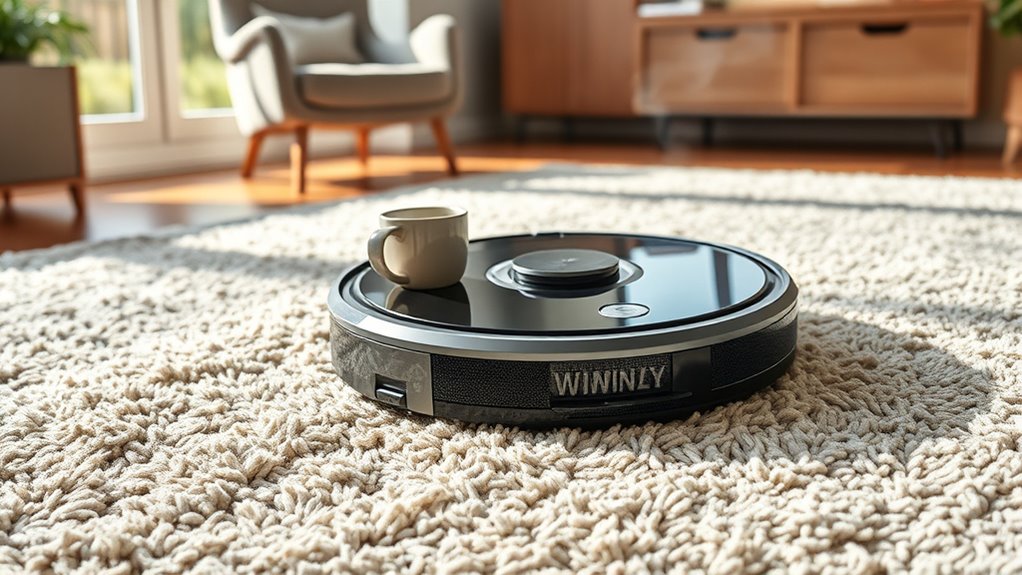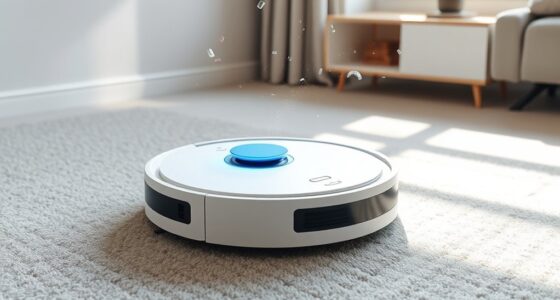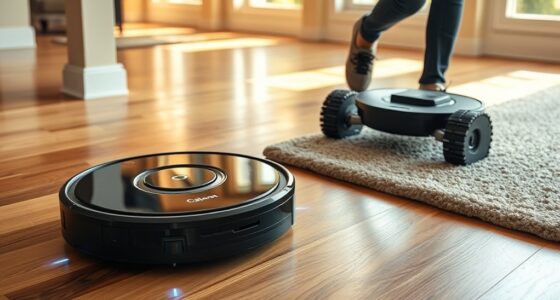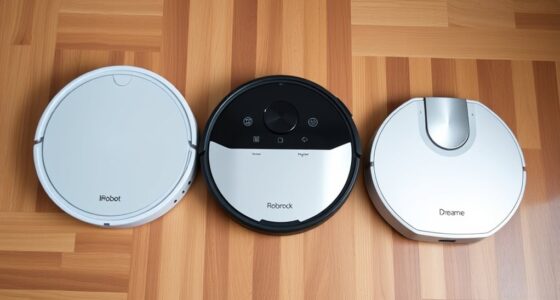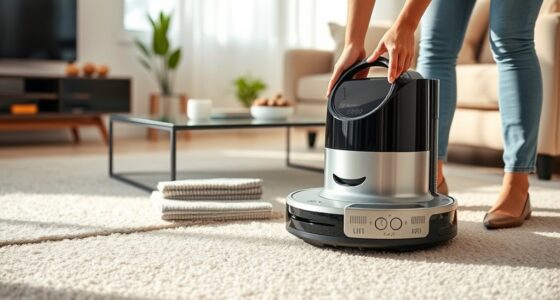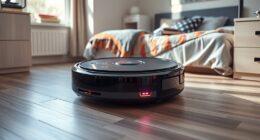Yes, a robot vacuum can work well on thick rugs if it has the right features, like adjustable height, powerful suction, and obstacle detection. Many models now adapt to different surfaces, tackling dense fibers effectively. However, some devices may struggle with very plush or high-pile carpets without these capabilities. To get the best performance, choose a model designed for thick surfaces—if you want to discover which ones excel, keep exploring.
Key Takeaways
- Many robot vacuums can clean thick rugs effectively with adjustable height and suction settings.
- Advanced models feature sensors that detect surface type and adapt cleaning parameters accordingly.
- Dense fibers may challenge suction and brush performance, requiring regular maintenance for optimal results.
- High-pile and plush rugs may cause some vacuums to get stuck or skip areas without proper obstacle avoidance.
- Choosing a model with strong suction, adjustable height, and smart navigation improves cleaning on thick rugs.
How Do Robot Vacuums Detect and Adapt to Different Surfaces?
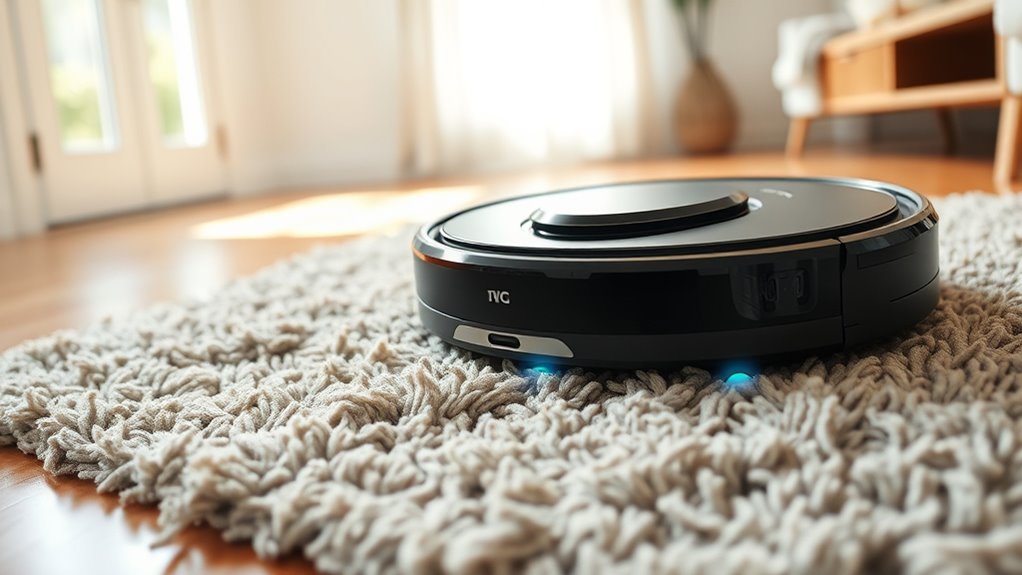
Robot vacuums detect and adapt to different surfaces by using sensors that analyze the floor as they move. These devices utilize robotic mapping to create a layout of your space, helping them navigate efficiently. During cleaning, they constantly assess the surface type, adjusting suction power and brush speed accordingly. Obstacle avoidance technology enables them to recognize furniture, cables, and other objects, preventing collisions and getting stuck. Advanced sensors detect changes in floor texture, allowing the vacuum to switch seamlessly between hardwood, tile, and carpeted areas. Additionally, many models incorporate air quality sensors that monitor the environment to optimize their cleaning performance. This combination of robotic mapping and obstacle avoidance guarantees thorough cleaning without human intervention. As a result, your robot can optimize its route, adapt to surface variations, and clean your floors effectively, even on mixed surfaces.
Challenges of Cleaning Thick Rugs With Robotic Devices
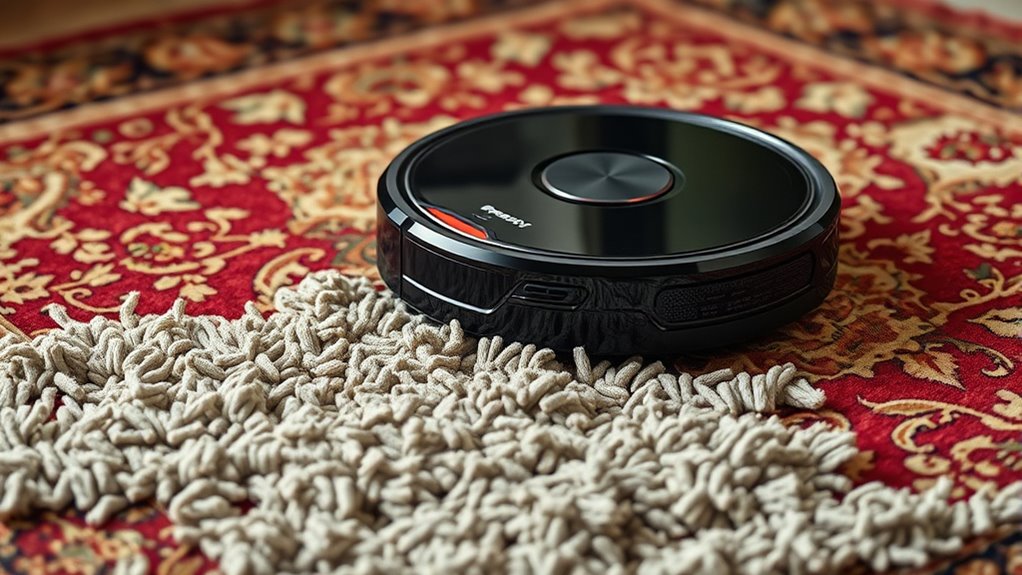
Cleaning thick rugs with robot vacuums can be tricky because their bristles and suction may struggle to reach deep fibers. You might also notice difficulty maneuvering over the dense material, which can limit coverage. Additionally, power and durability become concerns as these devices work harder to handle the extra thickness.
Bristle Depth and Suction
Despite advancements in robotic vacuum technology, thick rugs remain a significant challenge because their deep bristles and dense fibers can impede both bristle depth and suction power. When cleaning thick rugs, the bristle depth must be sufficient to reach deep into the fibers, but many robots have limited bristle length, reducing cleaning effectiveness. Additionally, dense fibers create resistance, which can diminish suction power, making it harder for the vacuum to lift dirt and debris effectively. If your robot’s suction isn’t strong enough, debris can get trapped beneath the surface, leading to incomplete cleaning. To improve results, look for models with adjustable or enhanced suction power and longer, more durable bristles designed specifically for thicker textures. These features are essential for tackling the challenges posed by deep, plush rugs. Moreover, understanding the technology behind suction systems can help you choose a device better suited for such demanding surfaces.
Maneuverability Over Thickness
Moving across thick rugs presents a unique set of challenges for robotic vacuums because their low clearance and limited articulation can hinder smooth movement. Navigation sensors may struggle to detect the rug’s depth, causing the vacuum to get stuck or skip areas. As the device tries to maneuver over uneven surfaces, it might require more adjustments, slowing cleaning progress. Additionally, frequent obstacle avoidance and increased effort over thick fibers can drain your vacuum’s battery faster, reducing overall cleaning time. To improve maneuverability, look for models with advanced navigation sensors that can better interpret thick rugs. Keep in mind that, even with these features, thick rugs can still impact the robot’s efficiency, making it essential to choose a device designed to handle varied textures and heights. Understanding the complexities of Real Couples and their relationships can also provide insights into how they balance privacy and shared experiences, much like managing the challenges of cleaning diverse surfaces.
Power Limitations and Durability
Robotic vacuums often face significant power and durability challenges when tackling thick rugs because their motors and brushes are not specifically designed for heavy resistance. As a result, their battery life can suffer, requiring more frequent recharges during cleaning sessions. You might notice that the vacuum slows down or struggles to maintain suction, reducing cleaning effectiveness. Additionally, increased motor strain often leads to higher noise levels, which can be disruptive. The durability of these devices may also be compromised over time if they consistently work against thick fibers, potentially causing wear and tear. To maximize performance, it’s essential to choose a model with a powerful motor and sturdy build, but even then, expect some limitations when cleaning dense, plush rugs. Volkswagen Tuning techniques highlight the importance of selecting equipment that matches the task’s demands for optimal results.
Features to Look for When Choosing a Robot Vacuum for Dense Textures
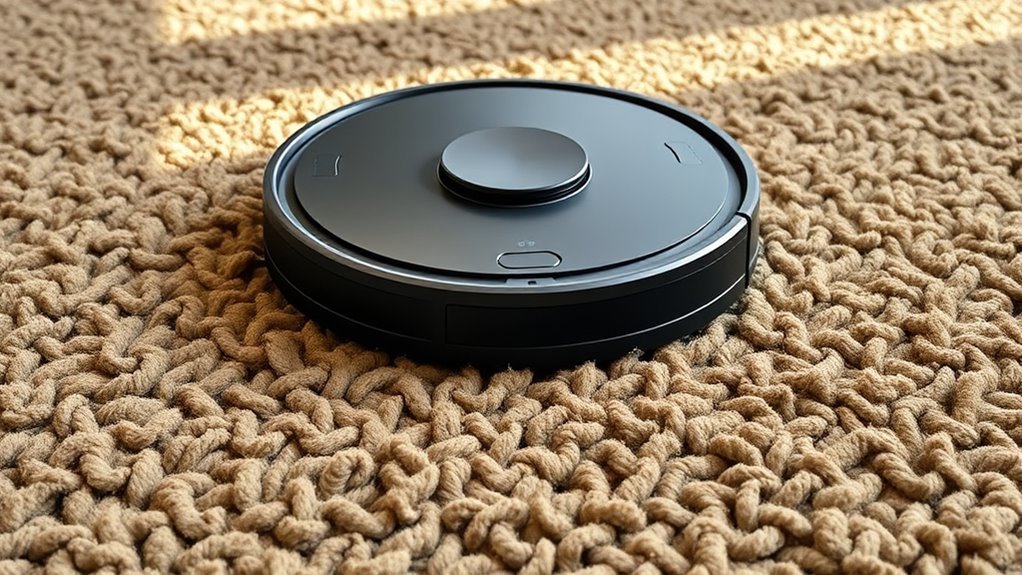
When selecting a robot vacuum for dense textures, you need to consider key features like suction power and adjustable settings to handle thick fibers effectively. Make sure it’s compatible with brush rolls designed for dense surfaces to ensure thorough cleaning. Additionally, check the height and clearance to make sure it can navigate your thick rugs without getting stuck. For optimal performance, choose models with water efficiency features, which often include enhanced power systems that can better manage challenging textures.
Suction Power and Settings
To effectively clean thick rugs, you need a robot vacuum with strong suction power and adjustable settings. High suction power directly boosts cleaning performance on dense textures, ensuring dirt and debris are lifted from deep within fibers. Look for models with adjustable suction levels so you can customize the power based on rug thickness. This flexibility helps prevent damage while maintaining ideal cleaning. Some vacuums offer eco or low-power modes for delicate or lighter cleaning tasks, preserving battery life. Strong suction combined with customizable settings allows you to tackle thick rugs efficiently without sacrificing device longevity. Remember, the right suction power and settings are essential for thorough cleaning and maintaining the appearance of your dense-textured rugs.
Brush Roll Compatibility
A brush roll that’s compatible with dense textures is essential for effectively cleaning thick rugs. Look for models with a high-torque or multi-surface brush roll designed to handle heavy fibers and deep pile. If you have pets, choose a brush roll optimized for robot pet hair removal, ensuring fur doesn’t clog or damage the mechanism. Noise level considerations matter too; a quieter brush roll helps you clean without disturbing your household. Some models feature adjustable brush speeds or specialized bristles that improve agitation for dense rugs and pet hair. Compatibility with thick textures means the brush roll can maintain contact with the carpet surface, loosening dirt and hair efficiently. Prioritize these features to get thorough cleaning results on your dense, plush rugs.
Height and Clearance
Choosing a robot vacuum with the right height and clearance is essential for effectively cleaning thick rugs. A low-profile design helps it navigate dense textures without getting stuck. Look for models with sufficient height clearance to avoid obstruction, especially on plush surfaces. Advanced obstacle detection features prevent collisions and ensure smooth movement over uneven fibers. Additionally, selecting a model that allows for customizable settings can enhance performance across various rug types and thicknesses.
| Feature | Benefit |
|---|---|
| Height Clearance | Allows cleaning on thick rugs |
| Obstacle Detection | Prevents jams and damage |
| Adjustable Height | Adapts to various rug pile heights |
| Compact Design | Maneuvers easily in tight spaces |
Top Brands and Models That Excel on Thick Rugs

When it comes to cleaning thick rugs effectively, certain robot vacuum brands and models stand out for their powerful suction and advanced brush systems. Look for options like the iRobot Roomba i7+, which handles pet hair removal with ease and minimizes the need for frequent robot vacuum maintenance. The Roborock S7 is another top choice, featuring strong suction and a self-cleaning brush that tackles deep fibers. Eufy RoboVac X8 Hybrid combines high performance with reliability on plush surfaces. These models excel at deep cleaning and are designed to work on thick rugs without getting stuck or losing suction. Keep in mind, regular maintenance ensures peak performance, especially when dealing with pet hair buildup. Additionally, understanding wall organization can help optimize cleaning routes and accessibility for your robot vacuum, ensuring thorough coverage on dense fibers. Choosing the right model can make a significant difference in your thick rug cleaning routine.
Tips for Optimizing Robot Vacuum Performance on Plush Surfaces
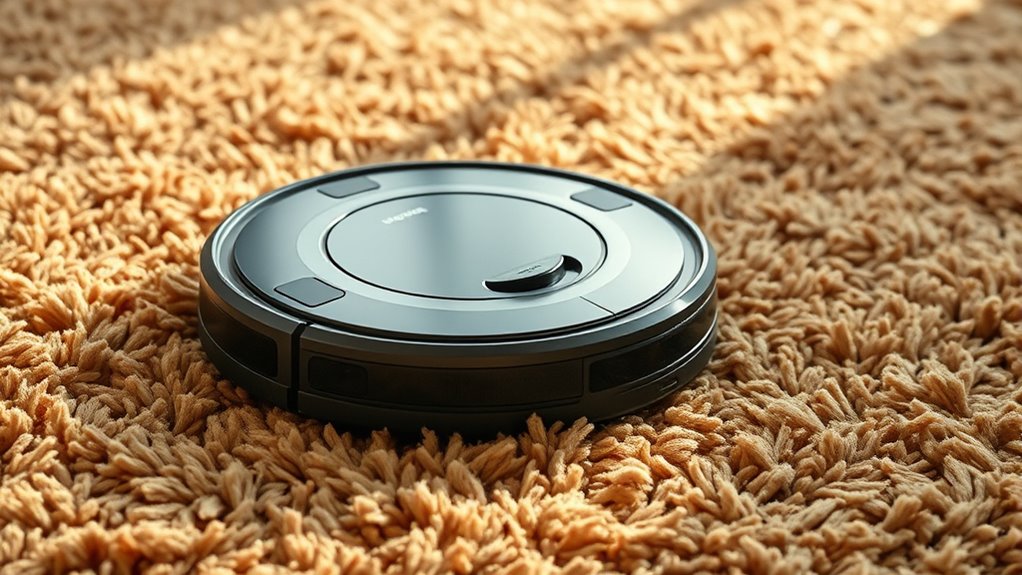
To get the most out of your robot vacuum on plush surfaces, focus on optimizing its settings and maintenance routines. Regularly clean the brushes and filters to ensure efficient pickup, especially with a robot pet shedding fur. Adjust the suction power if your vacuum has this feature—higher settings help lift debris from thick rugs. Properly map your space to prevent missed spots and overlapping. Additionally, maintaining clean surfaces can significantly improve cleaning effectiveness on plush and thick rugs. For smart home integration, set schedules during low-traffic times and enable voice commands for quick cleaning boosts. Keep the sensors clean to avoid getting stuck on plush surfaces. Remember, consistent maintenance improves performance and prolongs your device’s life.
- Regularly clean brushes and filters
- Adjust suction power as needed
- Utilize smart home features for convenience
Future Innovations in Robotic Cleaning for Thick and High-Pile Carpets
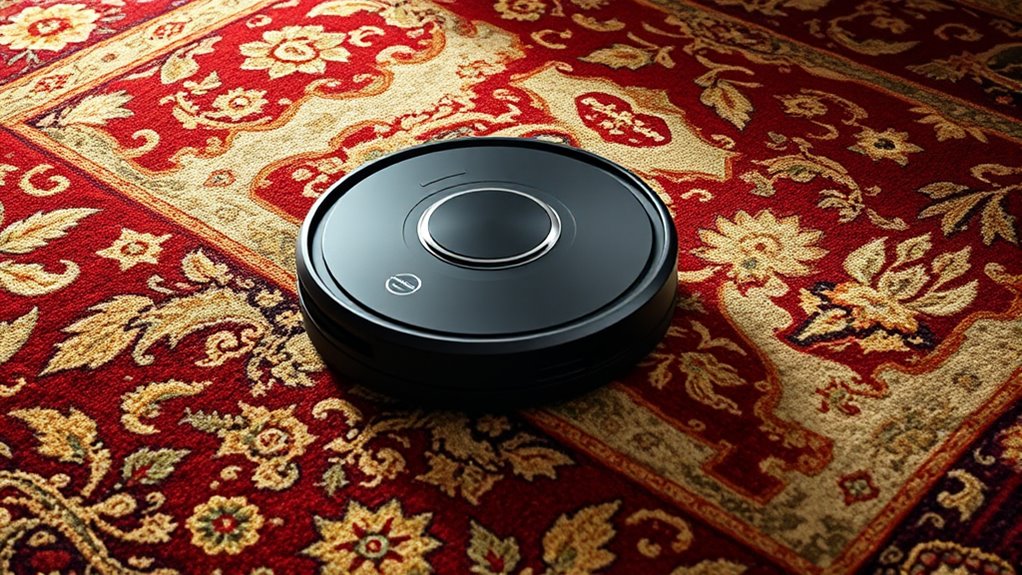
Advancements in robotic cleaning technology are poised to revolutionize how devices handle thick and high-pile carpets. Future innovations will likely include more powerful suction and adaptive brushes specifically designed for deep fibers, making it easier to remove robot pet hair from dense surfaces. Expect smarter navigation systems that can detect high-pile areas and adjust cleaning patterns accordingly, ensuring thorough coverage without getting stuck. Cordless convenience will improve with longer-lasting batteries and faster charging, giving you more flexibility during cleaning sessions. These innovations will also enable robot vacuums to better tackle stubborn debris and pet hair on plush carpets, making maintenance effortless. Additionally, understanding lease terms can help consumers make better decisions when selecting cleaning devices suited for their carpet types. Overall, upcoming developments promise a seamless, efficient cleaning experience tailored to thick and high-pile carpets, saving you time and effort.
Frequently Asked Questions
Can Robot Vacuums Effectively Clean All Types of Thick Rugs?
You might wonder if robot vacuums clean all thick rugs effectively. While they excel with cleaning patterns and maneuvering tight spaces, thick rugs can challenge their brush rolls and suction power. Battery efficiency also impacts cleaning duration on dense fibers. To get the best results, choose models with strong suction and adjustable height settings. Regular maintenance keeps them working efficiently, ensuring your thick rugs stay dust-free and clean.
How Long Does a Robot Vacuum Typically Last on Dense, High-Pile Carpets?
On dense, high-pile carpets, your robot vacuum typically lasts about 60 to 120 minutes per charge. The key factors are its battery life and navigation skills; well-designed models can cover more ground efficiently. Keep in mind, frequent use on thick rugs may drain the battery faster, so choosing a vacuum with strong battery performance and advanced navigation guarantees it cleans thoroughly without needing frequent recharges.
Are There Specific Maintenance Tips for Robot Vacuums on Thick Textures?
To keep your robot vacuum effective on thick textures, focus on edge cleaning regularly to remove debris stuck in corners and along edges. Also, maintain the battery by avoiding overcharging and keeping it clean, ensuring maximum performance. Check brushes and filters often, and clear any hair or fibers wrapped around the brushes. Proper maintenance helps your vacuum tackle dense rugs more efficiently and prolongs its lifespan.
Do Robot Vacuums Require Special Settings for Different Rug Materials?
You might wonder if your robot vacuum needs special settings for different rug materials. Most models with automatic navigation and obstacle detection adapt easily, adjusting suction and height for various textures. However, for thick rugs, you may need to manually increase the suction level or set the brush height higher. Always check your vacuum’s manual to guarantee efficient cleaning without damaging delicate or thick materials.
How Do Robot Vacuums Handle Pet Hair Embedded in Thick Rugs?
You might find it surprising, but robot vacuum limitations often become clear when tackling pet hair embedded in thick rugs. As you navigate this rug cleaning challenge, the vacuum’s brushes and suction may struggle to fully remove stubborn hair strands. Thick rugs can trap debris, making it harder for robot vacuums to clean thoroughly. To improve results, consider models with strong suction power and specialized brushes designed for deep cleaning.
Conclusion
If you’re wondering whether a robot vacuum can handle thick rugs, the answer depends on features like strong suction and adjustable brushes. Did you know that 65% of users report better cleaning results when choosing models designed for dense textures? By selecting the right device and following expert tips, you can keep your plush carpets spotless without lifting a finger. With ongoing innovations, future models will only get better at tackling high-pile surfaces effortlessly.
